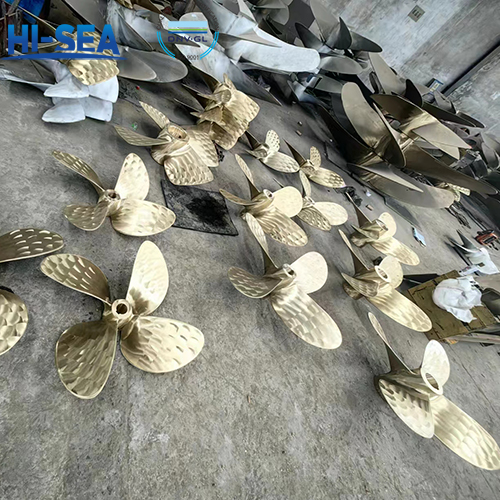
What is the marine propeller?
Two or more blades are connected to the hub, and their blade surfaces are helical or approximately helical for marine propulsion.
Generally installed at the stern of a ship, it has two or more blades connected to the hub, and the aft side of the blades is a helical or nearly helical propeller for ships.
A marine propeller is a mechanical device installed at the stern of a ship that generates thrust through rotation, causing the ship to move forward or backward. It is usually composed of multiple blades arranged around a central axis, and when the axis rotates, the blades propel the ship forward in the water. Marine propellers are one of the key components of modern ship propulsion systems.
Overview
A propeller consisting of a hub and several radially fixed blades, commonly known as a wheel blade. The propeller is installed below the waterline at the stern of the ship, and is powered by the main engine to rotate, pushing water towards the back of the ship and using the reactive force of the water to propel the ship forward. The propeller has a simple structure, light weight, high efficiency, and is protected below the waterline.
Ordinary transport ships have 1-2 propellers. Ships with high propulsion power can increase the number of propellers. Large fast passenger ships have twin to four propellers. A propeller generally has 3-4 blades, with a diameter depending on the ship's horsepower and draft. The lower end does not touch the bottom of the water, and the upper end does not exceed the full load waterline. The propeller speed should not be too high. For ocean cargo ships, the speed is around 100 revolutions per minute, while for small speedboats, the speed can be as high as 400-500 revolutions per minute, but efficiency will be affected. Propeller materials are generally made of manganese bronze or corrosion-resistant alloys, but stainless steel, nickel aluminum bronze, or cast iron can also be used.
A disc-shaped helical propulsion device that drives a ship forward. Composed of propeller blades and the hub connected to them. The commonly used ones are three leaf, four leaf, and five leaf. Including single propeller, ducted propeller, contra rotating propeller, tandem propeller, adjustable pitch propeller, supercavitating propeller, large skew propeller, etc. Propellers are usually installed at the stern of the ship (underwater). Marine propellers are mostly made of copper alloys, as well as cast steel, cast iron, titanium alloys, or non-metallic materials. The research on marine propellers is divided into two aspects: theoretical and experimental. In terms of theory, there are already theories and analysis methods such as momentum theorem, blade element theory, lift line theory, lift surface theory, boundary element method, etc., which can accurately predict the hydrodynamic performance of propellers and carry out theoretical design. The research on experiments mainly focuses on studying the performance of propellers through model tests and drawing propeller design diagrams. The design methods of marine propellers can be divided into two categories, namely theoretical design methods and graphic design methods.
Since the 1960s, ships have tended to become larger, and the use of high-power engines has led to issues such as stern vibration, structural damage, noise, and erosion caused by propeller excitation, which have attracted attention from various countries. The fundamental reason for propeller vibration is the increased load on the propeller blades, which can easily generate local unstable air bubbles when working in uneven wake behind the ship, resulting in continuous changes in the pressure, amplitude, and phase of the propeller acting on the hull.
Main features and functions
Blade design: The blade design of a propeller determines its efficiency and performance. The shape, quantity, and angle of the blades will affect the thrust and resistance of the propeller.
Material: Propellers are usually made of metal, such as Manganese Bronze (Cu1), Ni Mn Bronze (Cu2), Ni Al Bronze (Cu3), Manganese Aluminum Bronze (Cu4), etc., to ensure sufficient strength and corrosion resistance in water.
Propulsion efficiency: The design and manufacturing quality of propellers directly affect the fuel efficiency and speed of ships. Efficient propeller design can significantly reduce fuel consumption and pollution.
Application scope: From small speedboats to large merchant ships and warships, various types of ships use propellers as the main propulsion device.
For more marine propeller information, kindly please click





